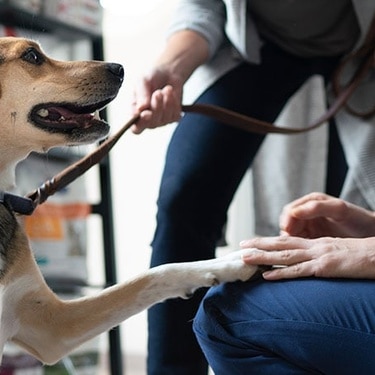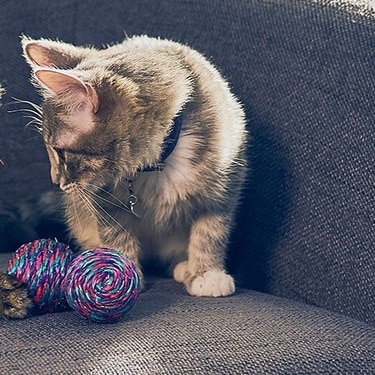
-
Hitta rätt mat för ditt husdjurGör det här testet för att se vilket foder som kan vara bäst för din pälskling.Hitta rätt mat för ditt husdjurGör det här testet för att se vilket foder som kan vara bäst för din pälskling.Utvalda produkter
 Hypoallergeniskt hundfoder för vuxna hundar med lax
Hypoallergeniskt hundfoder för vuxna hundar med laxHILL'S SCIENCE PLAN Hypoallergenic Large Breed Adult hundfoder med lax är ett komplett foder för vuxna hundar av stora raser i åldern 1–5 år. Det är särskilt framtaget för hundar med känslig hud och mage, med begränsade mängder högkvalitativa och nya proteinkällor samt utan spannmål.
Handla nu Hypoallergenic Adult Hundfoder
Hypoallergenic Adult HundfoderHill's Science Plan Hypoallergenic Adult våtfoder med lax är ett komplett helfoder av högsta kvalitet för alla vuxna hundar från 1 år och uppåt. Detta läckra våtfoder i burk är speciellt sammansatt för hundar med känslig hud och mage. Den innehåller en enda animalisk proteinkälla och är spannmålsfri.
Handla nu Healthy Mobility Medium Adult Hundfoder
Healthy Mobility Medium Adult HundfoderHill's Science Plan Healthy Mobility Medium Breed Adult Hundfoder med kyckling erbjuder en avancerad nutrition för att stödja ledhälsa och förbättra rörligheten. provides advanced nutrition to support joint health and improve mobility.
Handla nuHälsotillståndUtvalda produkter Sterilised Kattungefoder
Sterilised KattungefoderHill's SCIENCE PLAN Sterilised Kitten kattungefoder är skapat med Hill´s unika förståelse för de specifika behov som kastrerade kattungar har. Det bidrar med hög proteinkvalitet för muskelutveckling, med kontrollerat fett för att förebygga risk för övervikt efter kastrering. Dessutom har det en unik blandning av antioxidanter för att främja ett hälsosamt immunsystem för att stöjda din kattunges tillväxt.
Handla nu Hill's Science Plan Mature Adult Kattfoder Tonfisk
Hill's Science Plan Mature Adult Kattfoder TonfiskHill's Science Plan Adult kattfoder med lax är ett helfoder för äldre katter, speciellt utformat med ActivBiome+ Multi-Benefit teknologi.
Detta foder främjar ett värdigt åldrande hos katter och innehåller en synergistisk blandning av ingredienser som bidrar till att upprätthålla energi- och aktivitetsnivån.Handla nu Hill's Science Plan SENIOR VITALITY KATTFODER Kyckling, med laxHandla nu
Hill's Science Plan SENIOR VITALITY KATTFODER Kyckling, med laxHandla nu -
Till hundägare
- Tips och artiklar
-
Hälsokategori
- Vikthantering
- Miljö- och foderöverkänslighet
- Urinvägar
- Matsmältning
- Leder
- Njurar
-
Hundens livsstadium
- Näring för valpar
- Näring för vuxna katter
- Näring för seniorer
Till kattägare- Tips och artiklar
-
Hälsokategori
- Vikthantering
- Hud- & foderöverkänslighet
- Urinvägar
- Matsmältning
- Njurar
-
Kattens livsstadium
- Näring för kattungar
- Näring för vuxna
- Näring för seniorer
Utvalda artiklar Kristaller och stenar i hund- och katturin
Kristaller och stenar i hund- och katturinLäs om orsaker till och behandlingar av kristaller i hund- och katturin för att bibehålla hundens eller kattens hälsa. För expertråd om urinvård, besök Hill's Pet Sverige.
Läs mer Virtual Vet Visits: What You Need to Know
Virtual Vet Visits: What You Need to KnowLearn the ins and outs of a televet appointment before you talk to a vet online.
Läs mer Viktförändringar hos hundar och katter - kan det vara ett sköldkörtelproblem?
Viktförändringar hos hundar och katter - kan det vara ett sköldkörtelproblem?En viktförändring kan tyda på ett problem med sköldkörteln. Läs mer om tecken, orsaker och vad du kan göra åt det.
Läs mer -


If you're new to this whole cat parent thing, you might be feeling a little intimidated. Even if this new kitty isn't your first, adopting a new cat can be both exciting and overwhelming. It's easy to overlook something that you or your kitty might need to make her life more comfortable, especially for her first few days and weeks with you. Be sure you and your new cat have everything you need by following these ten tips to help you be the best pet parent to your new feline friend.
Before She Arrives
Before you bring your new furry friend home, take the time to prepare your home, your family, and yourself to make her transition to her new life is a seamless one.
1. Remove Potential Toxins
This is an important step to ensure your kitty's safety. Cats jump, climb and fit into small spaces, so look high and low for anything that might present a hazard, including household cleaning agents and other chemicals. Don't forget house plants — many common plants, including begonias, peace lilies and lucky bamboo are toxic to cats if eaten, and unfortunately cats love to eat plants. The American Society for the Prevention of Cruelty to Animals (ASPCA) provides a comprehensive list of plants that are toxic to cats, but for the safety of both your new cat and your plants, it's best to relocate all plants and flowers so she won't be able to nibble on them.
2. Finish Cat-Proofing Your Home
A lot of cats like to chew on cords and string. This not only poses a choking hazard, but also an electrocution hazard if she tries to eat an electrical cord. Be sure to secure all power cords, as well as pull cords on curtains and blinds, yarn, sewing thread and needles, decorative tassels, and anything else resembling string. Go through the house and check for any openings that would let her crawl into duct work, attics, crawl spaces or anywhere else she might become trapped, and double check that they're securely covered. If you have a dog door, you should also make sure she won't be able to use it as an escape hatch. The ASPCA recommends installing sturdy screens on all windows if they don't already have them, and making sure garbage cans are secured with tight-fitting lids.
3. Talk to Your Family
If you share your home with others, make sure everyone's on board with getting a new cat, and determine ahead of time who will be responsible for duties like feeding her and cleaning the litter box. If you have kids, establish rules and talk to them about safe ways to play with the cat.
4. Prepare Your Other Pets
If your new cat won't be an only pet, you'll need to plan on how to handle introductions carefully. PetMD recommends familiarizing your current pets with the new girl by letting them sniff something she's slept on or interacted with before bringing her into the house. Prepare a safe, small space for her to spend her first few days in isolation, such as a bathroom, to allow her to get acclimated to her new surroundings in peace. This will provide her places where she can hide from unwanted attention from other household members.
5. Buy Necessary Supplies
Food and water dishes, a litter box and cat litter will only serve her most basic needs. A good cat parent will of course also want her to be happy and comfortable. For this, you'll need grooming supplies like a cat brush, cat shampoo and nail trimmers, a variety of cat toys and at least one cat bed. If you want her to stay off the furniture, you'll likely need a cat bed for each room. Consider providing a cat tree to give her an alternative to jumping on cabinets or tables in order to satisfy her urge to perch on high ground. Scratching posts or pads will also give her an alternative to sharpening her nails on the furniture or carpet.


Smakrika tips
Kattungar kan behöva flera besök under sitt första år för vaccinationer. Vuxna katter har i allmänhet nytta av årliga kontroller, medan seniorkatter eller katter med särskilda behov kan behöva mer frekventa besök.
6. Stock up on Quality Food
To avoid tummy troubles, it's best to switch her food slowly, so if possible, try to get a week's supply of what the shelter or breeder was feeding her, and gradually switch her to your preferred brand of balanced and nutritious cat food.
Once She's Home
In the days and weeks following your new cat's homecoming, taking these steps will help ease her into her new life and help you be the best pet parent she could ever want.
7. Schedule a Wellness Check
As soon as you can, have your veterinarian check your cat over and make sure she's up to date on her shots. Your vet can also help you determine whether she should be neutered for a variety of health and safety reasons. If you don't already have an established relationship with a vet, be sure to consult friends and family members in the area that are happy with their veterinary experience. Remember, besides you and your family, your vet is the most important person in your cat's healthiness and happiness.
8. Get Her Some Bling
Accidents happen no matter how careful you are. Should your kitty manage to get separated from you and become lost, a collar with an ID tag that includes your contact information will help improve your chances of being reunited. Many shelters also microchip pets before they leave the shelter, so it can also be a good idea to ask more about that program in case of an unexpected escape.
9. Start Lessons ASAP
Kittens and younger cats may need to be taught to use a litter box, and cats of any age will need to learn the house rules. Discourage unwanted behavior by interrupting kitty and distracting her with a loud noise, and reward her with treats when she does the right thing. Try placing strips of tape sticky side up on furniture and other surfaces you don't want her to scratch, and try using catnip to lure her to desirable objects, such as cat beds and scratching posts.
10. Exercise Her Body and Mind
Cats become bored easily, and a bored cat often becomes a mischievous cat. Cat toys will not only keep her entertained and engage her mind, but also help her stay fit. If possible, create a perch by a window where kitty can sit and watch birds, squirrels, and people. And let her hone her hunting instincts while getting some exercise by hiding treats and toys around the house for her to find.
At the end of the day, your new kitty just wants to feel secure and loved, which is the goal of every cat parent. By following the steps outlined here, you can relax knowing that all of her major needs are covered, and focus instead on bonding with your newest friend.


Jean Marie Bauhaus är djurägare, bloggare och romanförfattare från Tulsa, Oklahoma, där hon vanligtvis skriver under överinseende av ett knä med pälsklingar.
Relaterade produkter

Hill's SCIENCE PLAN Sterilised Kitten kattungefoder är skapat med Hill´s unika förståelse för de specifika behov som kastrerade kattungar har. Det bidrar med hög proteinkvalitet för muskelutveckling, med kontrollerat fett för att förebygga risk för övervikt efter kastrering. Dessutom har det en unik blandning av antioxidanter för att främja ett hälsosamt immunsystem för att stöjda din kattunges tillväxt.

Hill's Science Plan Adult kattfoder med lax är ett helfoder för äldre katter, speciellt utformat med ActivBiome+ Multi-Benefit teknologi.
Detta foder främjar ett värdigt åldrande hos katter och innehåller en synergistisk blandning av ingredienser som bidrar till att upprätthålla energi- och aktivitetsnivån.

Hill's Science Plan Perfect Digestion Foder till Kattungar med Kyckling & Fullkornsris ger näring åt din kattunges unika mikrobiom och hjälper dem att nå sin fulla potential.

Relaterade artiklar

Discover how to train your cat, starting with very basic first steps that both reward good behavior and discourage the bad. It

Are you looking to get your cat more active? Does she constantly look bored? Then you may want to consider using a food-dispensing (also known as treat-dispensing) cat toy, which provides both physical and mental stimulation during snack times.

Upptäck roliga och engagerande spel för katter som även fungerar som bra motionskällor. Utforska spännande sätt att hålla din katt aktiv och underhållen!

Lär dig mer om orsakerna till hårbollar hos katter och upptäck effektiva behandlingar för att hålla din katt frisk. Besök Hill's Pet Sverige för fler råd om katters hälsa.

Sätt din katt på diet utan att den märker det
Vår kalorifattiga sammansättning hjälper dig att kontrollera din katts vikt. Den innehåller högkvalitativt protein för att bygga slanka muskler och är tillverkad med noga utvalda ingredienser för en smakrik och näringsrik måltid. Kliniskt bevisade antioxidanter, vitamin C+E, bidrar till ett friskt immunförsvar.
Sätt din katt på diet utan att den märker det
Vår kalorifattiga sammansättning hjälper dig att kontrollera din katts vikt. Den innehåller högkvalitativt protein för att bygga slanka muskler och är tillverkad med noga utvalda ingredienser för en smakrik och näringsrik måltid. Kliniskt bevisade antioxidanter, vitamin C+E, bidrar till ett friskt immunförsvar.


